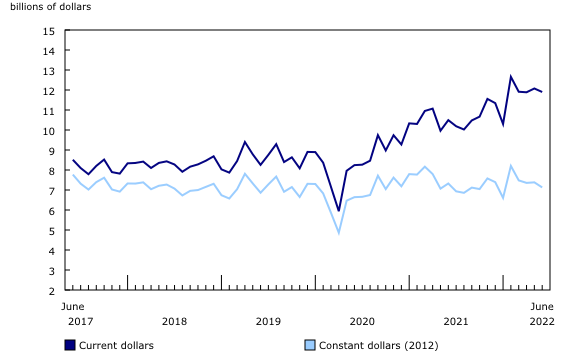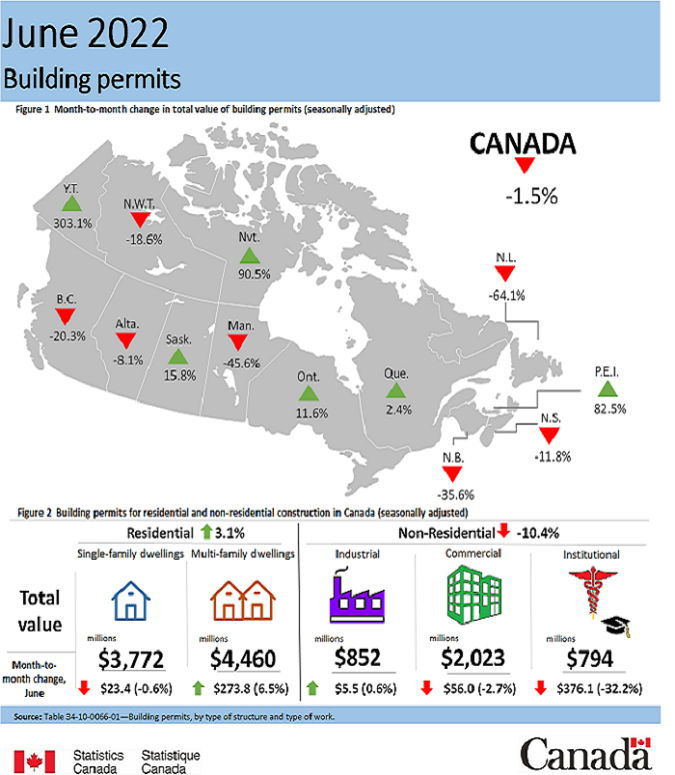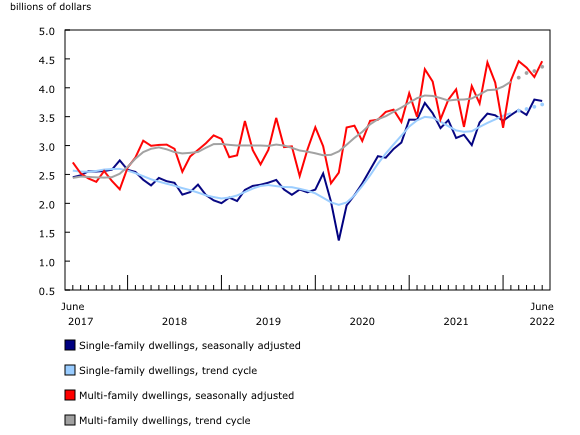Building permits, June 2022
Archived Content
Information identified as archived is provided for reference, research or recordkeeping purposes. It is not subject to the Government of Canada Web Standards and has not been altered or updated since it was archived. Please "contact us" to request a format other than those available.
Released: 2022-08-04
$11.9 billion
June 2022
-1.5% 
(monthly change)
$19.8 million
June 2022
-64.1% 
(monthly change)
$74.5 million
June 2022
82.5% 
(monthly change)
$229.2 million
June 2022
-11.8% 
(monthly change)
$131.4 million
June 2022
-35.6% 
(monthly change)
$2,224.9 million
June 2022
2.4% 
(monthly change)
$5,333.6 million
June 2022
11.6% 
(monthly change)
$163.2 million
June 2022
-45.6% 
(monthly change)
$211.6 million
June 2022
15.8% 
(monthly change)
$1,396.6 million
June 2022
-8.1% 
(monthly change)
$2,018.5 million
June 2022
-20.3% 
(monthly change)
$75.6 million
June 2022
303.1% 
(monthly change)
$3.9 million
June 2022
-18.6% 
(monthly change)
$17.1 million
June 2022
90.5% 
(monthly change)
The total value of building permits in Canada declined 1.5% in June to $11.9 billion, mainly due to the non-residential sector, which dropped 10.4% to $3.7 billion, after posting its second-highest monthly value.
On a constant dollar basis (2012=100), the total value of building permits decreased 3.4% to $7.2 billion.
Ontario pushes up residential sector
The value of residential permits in June increased 3.1% to $8.2 billion nationally.
The value of multi-family building permits increased 6.5%, with Ontario (+24.8%) leading the way, due to several apartment buildings being built in Mississauga. Overall, 15 out of the 20 highest value permits submitted across all sectors were for apartment or condo buildings.
Construction intentions in the single-family home component declined 0.6% due to large decreases in Manitoba and Newfoundland and Labrador. Gains in Ontario (+2.1%) helped to counter these losses.
Non-residential sector down in June
The total value of non-residential sector permits fell 10.4% to $3.7 billion, largely due to decreases in British Columbia's commercial and institutional components.
Commercial permit values decreased 2.7%, with declines in eight provinces. In contrast, Ontario saw a notable increase (+37.5%), driven by a permit for a large office building in the city of Toronto.
Construction intentions in the institutional component fell 32.2%, following strong growth in May resulting from a large hospital permit in British Columbia.
Conversely, the value of industrial permits rose 0.6%. Notably, it shot up 206.0% in Saskatchewan, largely due to the construction of a new power plant in Moose Jaw.
Record high reached in second quarter of 2022
In the second quarter of 2022, the total value of building permits increased 2.8% from the previous quarter to $35.9 billion with gains in both the residential and non-residential sectors.
The residential sector increased 7.2% this quarter, with gains in the value of both single- (+5.0%) and multi- (+9.3%) family permits. British Columbia led the growth, followed by Alberta and Ontario.
The number of new residential units rose 6.0%, after a decline of 7.8% the previous quarter. This incline was driven by a rebound in the multi-unit component (+8.9%).
The non-residential sector decreased 5.1%, following a strong first quarter. The institutional component (-21.9%) dragged down the sector, following the issuance of two large hospital permits in the last quarter. Commercial permits declined 0.6%, while industrial permits posted gains of 11.4%.
To explore data using an interactive user interface, visit the Building permits: Interactive Dashboard.
To explore the impact of the COVID-19 pandemic on the socioeconomic landscape, please consult the Canadian Economic Dashboard and COVID-19.
For more information on housing, please visit the Housing statistics portal.
Statistics Canada has a Housing Market Indicators dashboard. This web application provides access to key housing market indicators for Canada, by province and by census metropolitan area. The indicators are updated automatically with new information from monthly releases, giving users access to the latest data.
Note to readers
Unless otherwise stated, this release presents seasonally adjusted data with current dollar values, which facilitate month-to-month and quarter-to-quarter comparisons by removing the effects of seasonal variations. For information on seasonal adjustment, see Seasonally adjusted data – Frequently asked questions.
Building components
- Single-family dwellings: Residential buildings containing only one dwelling unit (e.g., single-detached house, bungalow, linked home [linked at the foundation]).
- Multi-family dwellings: Residential buildings containing multiple dwelling units (e.g., apartment, apartment condominium, row house, semi-detached house).
- Industrial buildings: Buildings used in the processing or production of goods, or related to transportation and communication.
- Commercial buildings: Buildings used in the trade or distribution of goods and services, including office buildings.
- Institutional and government buildings: Buildings used to house public and semi-public services, such as those related to health and welfare, education, or public administration, as well as buildings used for religious services.
Revision
Data are subject to revisions based on late responses, methodological changes and classification updates. Unadjusted data has been revised for the previous three months. Seasonally adjusted data has been revised for the previous four months.
For information on trend-cycle data, see the StatCan Blog and Trend-cycle estimates – Frequently asked questions.
Next release
Data on building permits for July will be released on September 1.
Contact information
For more information, or to enquire about the concepts, methods or data quality of this release, contact us (toll-free 1-800-263-1136; 514-283-8300; infostats@statcan.gc.ca) or Media Relations (statcan.mediahotline-ligneinfomedias.statcan@statcan.gc.ca).
- Date modified:





